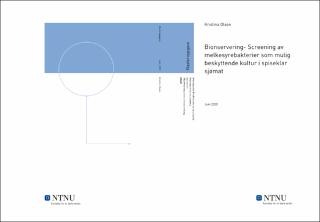| dc.contributor.advisor | Jakobsen, Anita Nordeng | |
| dc.contributor.advisor | Hoel, Sunniva | |
| dc.contributor.author | Olsen, Kristina D. | |
| dc.date.accessioned | 2021-09-25T16:09:49Z | |
| dc.date.available | 2021-09-25T16:09:49Z | |
| dc.date.issued | 2020 | |
| dc.identifier | no.ntnu:inspera:57241646:19399497 | |
| dc.identifier.uri | https://hdl.handle.net/11250/2782570 | |
| dc.description.abstract | Forbrukernes ønske om spiseklare sjømatprodukter med høy sensorisk og ernæringsmessig kvalitet er utfordrende og kan medføre økt matsvinn. For å hindre dette bør barriereteknologi anvendes for å sikre trygg mat med tilstrekkelig holdbarhet. En mulig innovativ tilnærming er biokonservering ved hjelp av melkesyrebakterier. Biokonservering er bruk av en naturlig eller kontrollert mikroflora, antimikrobielle metabolitter, eller en kombinasjon av disse for å forhindre uønsket bakterievekst, eller endring av produktets næringsinnhold og sensoriske egenskaper.
Hensikten med studien var å screene et utvalg melkesyrebakterier isolert fra røykalaks, gravlaks og sushi for deres inhiberende egenskaper mot forringelsesorganismene Shewanella putrefaciens og Pseudomonas fluorescens. I den forbindelse ble vekstegenskapene til melkesyrebakteriene ved 15 °C undersøkt, og screeningmetoden optimalisert ved utarbeidelse av en standardkurve (OD mot kde/ml) og testing av selektive og/eller differensielle medier. Screeningen forløp ved oppdyrkning av melkesyrebakterier og målorganismer i co-kultur og kvantifisering ved hjelp av mikrospotting. Melkesyrebakteriene ble identifisert ved hjelp av 16S rRNA gen sekvensering og stammene med inhiberende egenskaper og inkludert i et rørforsøk hvor målet var å dokumentere deres vekstkinetikk under forhold tilsatt 0, 26 % røyksyrekondensat.
93 av 100 melkesyrebakterier hadde vekst ved 15 °C og brønnplateoppsettet og mikrospotting under screeningen av P. fluorescens fungerte godt. 35 av 93 stammer ble videre screenet for inhiberende egenskaper hvor 13 stammer av Leuconostoc (12 fra sushi og 1 fra gravlaks) og én stamme av Carnobacterium (fra sushi) hadde en inhiberende effekt mot målorganismen P. fluorescens med en gjennomsnittlig reduksjon på 3,4 log kde/ml. Stammen identifisert som Weissella hadde ingen inhiberende effekt. Brønnplateoppsettet for S. putrefaciens krever imidlertid optimalisering, på grunn av manglende vekst i fiskejuice og hvit kolonidannelse på jernagar ved 15 °C.
Ved oppformering av melkesyrebakterier i Brain Heart Infusion- buljong (BHI- buljong) tilsatt røyksyrekondensat ble 13 av 14 stammer hemmet i form av en forlenget lag-fase, og noen med en lavere cellekonsentrasjon ved stagnering enn kontrollen. Stamme nr. 299 hadde ingen registrert lag- fase og endte opp med samme cellekonsentrasjon som kontrollen. Den ansees derfor som en god kandidat som fremtidig biokonserverende faktor i kaldrøkt laks produsert med røyksyrekondensat. | |
| dc.description.abstract | Consumers' desire for ready-to-eat seafood products with high sensory and nutritional quality is challenging and can lead to increased food waste. To prevent this, barrier technology should be used to ensure safe food with adequate shelf life. A possible innovative approach is biopreservation using lactic acid bacteria. Biopreservation is the use of a natural or controlled microflora, antimicrobial metabolites, or a combination of these to prevent unwanted bacterial growth or change the nutritional content and sensory properties of the product.
The aim of the study was to screen a selection of lactic acid bacteria isolated from cold smoked salmon, graved salmon and sushi for their inhibitory properties against the spoilage organisms Shewanella putrefaciens and Pseudomonas fluorescens. The growth characteristics of the lactic acid bacteria at 15 °C were investigated and the screening method optimized by preparing a standard curve for the lactic acid bacteria and testing of selective and/or differential media for lactic acid bacteria and target organisms. The screening was carried out by cultivation of lactic acid bacteria and target organisms in co-culture and quantification by micro spotting. The lactic acid bacteria were identified by 16s- rRNA gene sequencing and the strains with inhibitory properties were included in a tube experiment to determine their growth kinetics under conditions added 0,26 % purified condensed smoke.
93 out of 100 lactic acid bacteria grew at 15 °C and the well plate setup and micro spotting during the screening of P. fluorescens worked well. 35 of 93 strains were further screened for inhibitory properties, with 13 strains of Leuconostoc (12 from sushi and 1 from tomb salmon) and one strain of Carnobacterium (from sushi) having an inhibitory effect against the target organism P. fluorescens with an average reduction of 3.4 log kde / ml. The strain identified as Weissella had no inhibitory effect. The well plate setup for S. putrefaciens requires optimization, due to lack of growth in fish juice and white colony formation on iron agar (IA) at 15 °C.
For the lactic acid bacteria in BHI, added purified condensed smoke, 13 of 14 strains were inhibited in the form of an extended lag- phase, and some with a lower cell concentration at stagnation than the control. Strain 299 had no recorded lag and ended up with the same cell concentration as the control. This stain is therefore considered a good candidate as a possible bio-preserving factor in cold smoked salmon produced with purified condensed smoke. | |
| dc.language | | |
| dc.publisher | NTNU | |
| dc.title | Biokonservering- Screening av melkesyrebakterier som mulig beskyttende kultur i spiseklar sjømat | |
| dc.type | Master thesis | |
